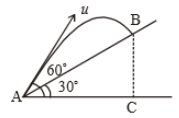A particle is projected at an angle with horizontal with an initital speed u. When it makes an angle with horizontal, its speed v is-
1.
2.
3.
4.
A body is projected with velocity m/s with an angle of projection 60 with horizontal. Calculate velocity on that point where body makes an angle 30 with the horizontal.
1. 20 m/s
2.
3.
4. 10 m/s
A particle is projected with a velocity u making an angle with the horizontal. At any instant, its velocity v is at right angles to its initial velocity u; then v is:
1. ucos
2. utan
3. ucot
4. usec
A projectile is given an initial velocity of . The cartesian equation of its path is (g = 10 )
1.
2.
3.
4.
Time taken by the projectile to reach from A to B is t. Then the distance AB is equal to :


1.
2.
3.
4. 2ut
A particle projected with kinetic energy with an angle of projection . Then the variation of kinetic K with vertical displacement y is
1. linear
2. parabolic
3. hyperbolic
4. periodic
A body is thrown horizontally with a velocity \(\sqrt{2 g h}\) from the top of a tower of height \(h\). It strikes the level ground through the foot of the tower at a distance \(x\) from the tower. The value of \(x\) is:
| 1. | \( h \) | 2. | \(\frac{h}{2} \) |
| 3. | \(2 h \) | 4. | \( \frac{2 h}{3}\) |
A body is projected with a velocity \(u\) with an angle of projection \(\theta.\) The change in velocity after the time \((t)\) from the time of projection will be:
| 1. | \(gt\) | 2. | \(\frac{1}{2}gt^2\) |
| 3. | \(u\sin\theta\) | 4. | \(u\cos\theta\) |
What determines the nature of the path followed by the particle?
1. Speed only
2. Velocity only
3. Acceleration only
4. None of these
A ball P is dropped vertically and another ball Q is thrown horizontally from the same height and at the same time. If air resistance is neglected, then
1. Ball P reaches the ground first
2. Ball Q reaches the ground first
3. Both reach the ground at the same time
4. The respective masses of the two balls will decide the time






